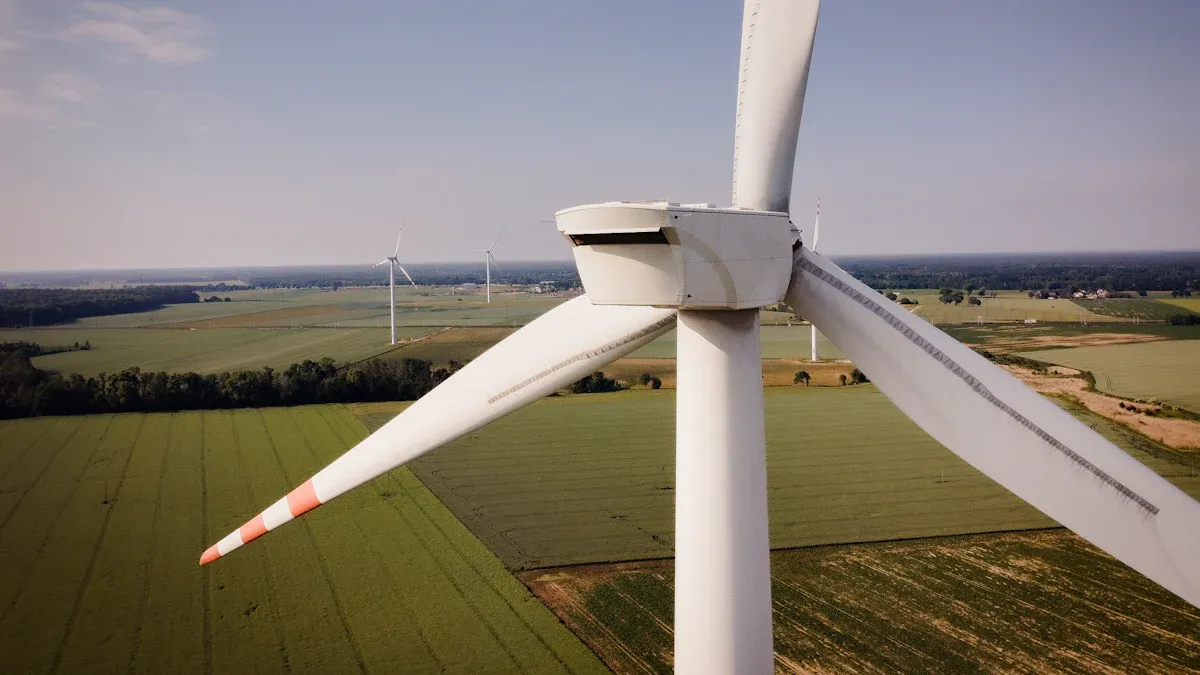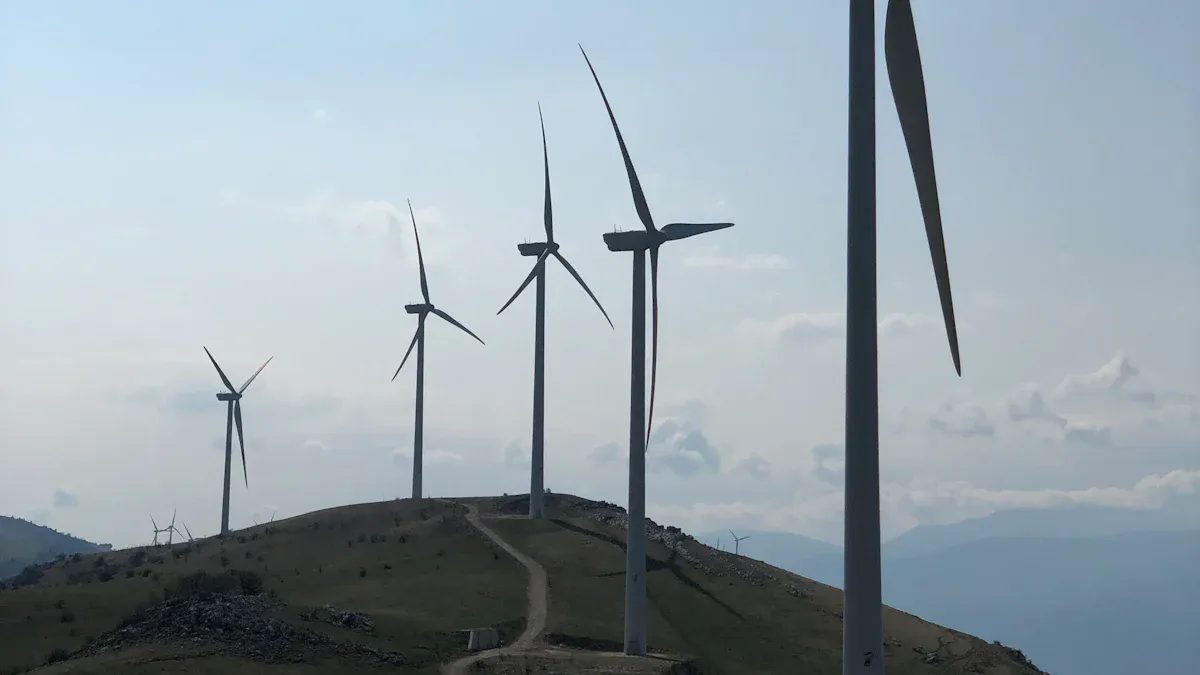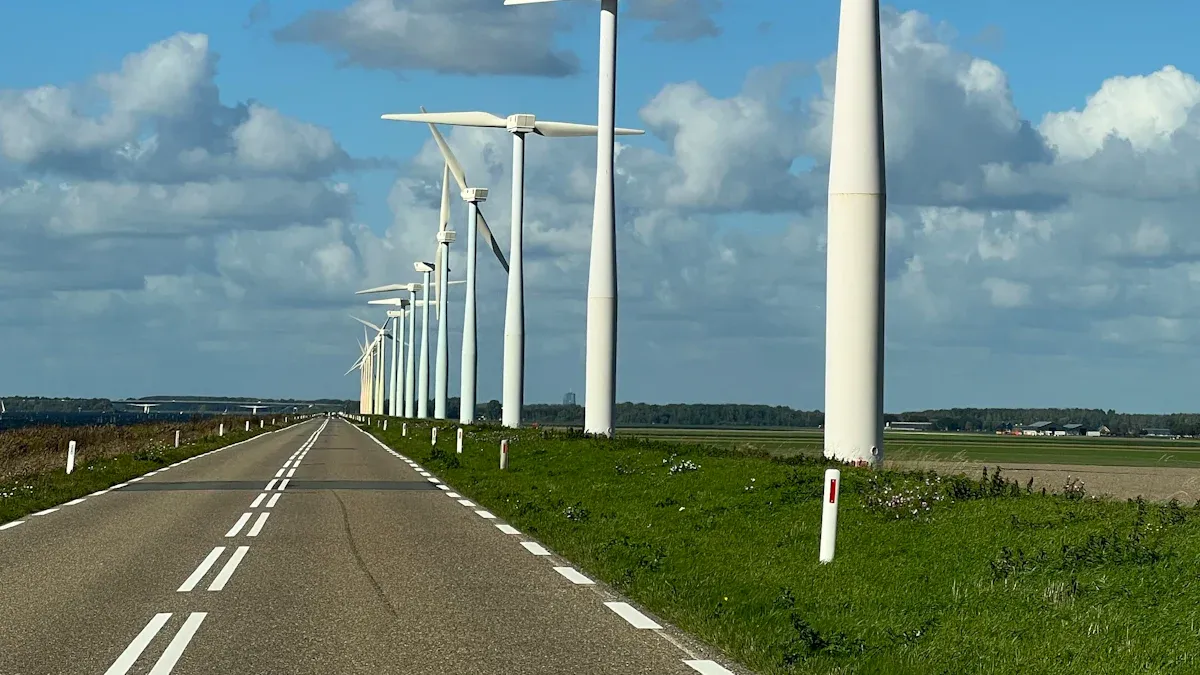
When it comes to wind turbine performance in Europe’s high-wind regions, durability and reliability are non-negotiable. Forged shafts excel in these conditions due to their superior fatigue resistance and mechanical strength. Studies, such as ‘Fatigue life on a full scale test rig: Forged vs. Cast wind turbine rotor shafts,’ reveal that forged components withstand extreme weather stresses far better than cast alternatives. This resilience ensures turbines operate efficiently, even under relentless wind loads. Choosing forged vs. cast shafts isn’t just a preference—it’s a necessity for long-term performance and safety.
Key Takeaways
- Forged shafts are tougher and last longer than cast shafts.
- Forging arranges the metal’s grain, making it stronger and less flawed.
- Using forged shafts means spending less on repairs and replacements.
- Forged shafts work well even in bad weather, keeping turbines running.
- Buying forged shafts helps wind power stay reliable and efficient.
Key Performance Factors in High-Wind Regions

Material Strength and Fatigue Resistance
When I evaluate the performance of wind turbine shafts, material strength and fatigue resistance stand out as critical factors. Forged shafts consistently outperform cast shafts in these areas. Their superior strength comes from the forging process, which aligns the metal’s grain structure to enhance durability. This alignment reduces the likelihood of defects, ensuring the shaft can withstand the relentless stress of high winds.
To illustrate this, let me share a comparison:
| Feature | Forged Shafts | Cast Shafts |
|---|---|---|
| Strength | Generally stronger due to grain alignment | Weaker due to linear grain flow |
| Fatigue Resistance | Enhanced fatigue resistance | Lower fatigue resistance |
| Defect Likelihood | Reduced likelihood of defects | Higher likelihood of defects |
| Performance Under Stress | Superior performance under harsh conditions | Less effective under stress |
| Manufacturing Process | Multiple forging processes | Single casting process |
This table highlights why forged shafts are the preferred choice for wind turbines in demanding environments. Their ability to endure repeated stress cycles without failure ensures long-term reliability. When comparing forged vs. cast shafts, the difference in fatigue resistance alone makes forged shafts the clear winner.
Environmental Challenges in Europe’s High-Wind Areas
Europe’s high-wind regions present unique challenges for wind turbine performance. I’ve seen studies that emphasize how weather patterns, such as high-pressure systems and atmospheric blockings, can cause significant variations in wind speeds. These anomalies make it harder to predict and manage power production.
As the EU pushes toward climate neutrality by 2050, the reliance on renewable energy sources like wind power will only grow. However, this dependency also increases the risk of power supply disruptions during extreme weather events. For example, blocking events can reduce wind speeds in key areas, leading to sudden drops in energy output. This unpredictability underscores the need for robust turbine components that can handle fluctuating conditions.
Forged shafts, with their enhanced strength and fatigue resistance, provide the reliability needed to maintain consistent performance in these challenging environments. By choosing forged over cast shafts, we can ensure turbines operate efficiently, even when the weather doesn’t cooperate.
Forged Shafts: Strengths and Weaknesses
Forging Process and Its Impact on Shaft Properties
When I think about the forging process, I see it as the foundation of a forged shaft’s superior performance. Forging involves shaping metal under high pressure, which aligns the grain structure in the direction of the applied force. This alignment enhances the shaft’s strength, durability, and resistance to fatigue. Unlike casting, which pours molten metal into molds, forging eliminates common defects like porosity and cavities. This makes forged shafts far more reliable in demanding applications.
To better understand how the forging process influences key properties, let me share this comparison:
| Key Property | Forged Components | Cast Components |
|---|---|---|
| Strength | Increased in longitudinal direction | Isotropic properties in all directions |
| Ductility | Varies with directionality | Generally between longitudinal and transverse values |
| Impact Strength | Directional properties | Isotropic properties |
| Anisotropy | Exhibits different values in different directions | Uniform properties across all directions |
This table highlights why forged shafts are the preferred choice for wind turbines. Their directional strength and reduced defect likelihood make them ideal for high-stress environments. I’ve seen firsthand how these properties translate into better performance and longer service life.
Performance Advantages in High-Wind Conditions
In Europe’s high-wind regions, turbines face relentless stress from fluctuating wind speeds and extreme weather. Forged shafts excel in these conditions because of their unmatched strength and durability. The forging process creates a finer grain structure and continuous grain flow, which enhances fatigue resistance and reduces the risk of failure under cyclic loads. This is critical for wind turbines, where components endure constant stress.
Let me illustrate the advantages of forged shafts in high-wind conditions:
| Advantage | Description |
|---|---|
| Increased Strength | Forged crankshafts are stronger due to tighter grain flow from the forging process. |
| Enhanced Durability | Forged components can withstand higher stress levels and perform effectively under harsh conditions. |
| Improved Microstructure | The forging process results in a finer grain size and continuous grain flow, enhancing performance. |
| Reduced Defects | Forging minimizes the likelihood of defects such as porosity and cavities, common in casting. |
| Greater Fatigue Resistance | Forged parts are more robust and wear-resistant, making them ideal for cyclic loads. |
| Stable Performance | Forged crankshafts generally offer more stable performance compared to cast crankshafts. |
These benefits make forged shafts the clear winner in the “Forged vs. Cast” debate for wind turbine applications. Their ability to handle high stress and maintain stable performance ensures turbines operate efficiently, even in the harshest conditions. I always recommend forged shafts for their reliability and long-term value.
Cast Shafts: Strengths and Weaknesses
Casting Process and Its Impact on Shaft Properties
When I think about the casting process, I see it as a simpler and more cost-effective method compared to forging. Casting involves pouring molten metal into a mold, allowing it to cool and solidify into the desired shape. This process enables manufacturers to create complex geometries with ease, making cast shafts an attractive option for applications where intricate designs are required.
However, the simplicity of casting comes with trade-offs. The grain structure in cast shafts forms randomly during solidification, which can lead to weaker mechanical properties. Defects such as porosity and shrinkage are more common in cast components, reducing their reliability under high stress. While casting offers flexibility in design, it sacrifices the strength and durability that forged shafts provide.
Here’s a quick comparison of the casting process versus forging:
| Feature | Casting Process | Forging Process |
|---|---|---|
| Complexity of Design | Allows intricate shapes | Limited to simpler designs |
| Grain Structure | Randomized during solidification | Aligned for enhanced strength |
| Defect Likelihood | Higher risk of porosity and shrinkage | Reduced risk of defects |
| Mechanical Properties | Generally weaker | Superior strength and fatigue resistance |
While cast shafts may seem appealing for their design flexibility, I always recommend considering the long-term performance needs of the application.
Limitations in High-Wind Conditions
In Europe’s high-wind regions, cast shafts struggle to match the performance of forged alternatives. I’ve seen how the unpredictable weather in these areas places immense stress on wind turbine components. Cast shafts, with their weaker grain structure and higher defect likelihood, are more prone to failure under cyclic loads.
For example, when wind speeds fluctuate rapidly, turbine shafts experience repeated stress cycles. Cast shafts often develop cracks or fractures over time, leading to costly repairs and downtime. Their lower fatigue resistance makes them less reliable for applications where durability is critical.
Let me share a few key limitations of cast shafts in high-wind conditions:
- Reduced Fatigue Resistance: Cast shafts wear out faster under cyclic loads, increasing the risk of failure.
- Higher Defect Likelihood: Porosity and shrinkage weaken the shaft’s ability to handle stress.
- Lower Long-Term Reliability: Cast components require more frequent maintenance, driving up operational costs.
When comparing forged vs. cast shafts, the choice becomes clear. Forged shafts offer the strength and reliability needed to withstand Europe’s challenging wind conditions. Cast shafts may work for less demanding applications, but they fall short in high-stress environments.
Forged vs. Cast: Comparative Analysis

Durability and Fatigue Resistance
When I compare forged and cast shafts, durability and fatigue resistance stand out as the most critical factors. Forged shafts consistently outperform cast ones in these areas. The forging process aligns the metal’s grain structure, creating a stronger and more fatigue-resistant component. This makes forged shafts ideal for wind turbines, which face constant stress from high winds.
Cast shafts, on the other hand, have a random grain structure due to the solidification process. This randomness increases the likelihood of defects like porosity and shrinkage, which weaken the shaft over time. In high-wind regions, where turbines endure relentless stress cycles, these weaknesses can lead to premature failure.
I always recommend forged shafts for their superior durability. Their ability to withstand repeated stress without cracking ensures long-term reliability, even in the harshest conditions.
Cost-Effectiveness and Manufacturing Efficiency
Cost-effectiveness often depends on the production method. Casting uses patterns, which are cheaper than the dies required for forging. For small production runs or complex designs, casting may seem more economical. However, the total cost of a part includes more than just its initial price. Additional machining costs to achieve the desired shape can quickly add up.
For simpler designs and higher production volumes, forging becomes more efficient. Dies, though initially expensive, can be amortized over large production runs, reducing the per-unit cost. Forged shafts also require less maintenance and replacement, saving money in the long run.
Here’s a quick comparison:
| Factor | Forging Process | Casting Process |
|---|---|---|
| Initial Tooling Cost | Higher due to die creation | Lower due to pattern creation |
| Machining Requirements | Moderate for simpler designs | Lower for complex designs |
| Long-Term Cost | Lower due to durability | Higher due to frequent replacements |
While casting may offer short-term savings, I believe forged shafts provide better value over the lifespan of a wind turbine.
Long-Term Reliability in High-Wind Regions
Long-term reliability is non-negotiable for wind turbines in Europe’s high-wind regions. Forged shafts excel in this area. Their superior strength and fatigue resistance ensure they can handle the constant stress of fluctuating wind speeds. This reliability minimizes downtime and maintenance costs, keeping turbines operational when energy demand is high.
Cast shafts, with their higher defect likelihood, struggle to match this performance. Over time, the stress from cyclic loads can cause cracks or fractures, leading to costly repairs. In my experience, choosing forged shafts is the best way to ensure consistent performance and avoid unexpected failures.
When it comes to “Forged vs. Cast,” the choice is clear. Forged shafts deliver the durability, cost-effectiveness, and reliability needed to thrive in Europe’s challenging wind conditions.
After evaluating the performance of forged and cast shafts, I can confidently say that forged shafts are the superior choice for Europe’s high-wind regions. Their unmatched mechanical strength, fatigue resistance, and long-term reliability make them indispensable for wind turbine applications.
- Why Choose Forged Shafts?
- They endure extreme stress without compromising performance.
- Their durability ensures fewer maintenance needs and lower costs.
- They provide consistent energy output, even in harsh conditions.
Post time: Mar-31-2025



